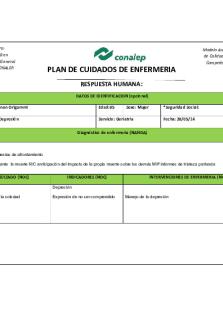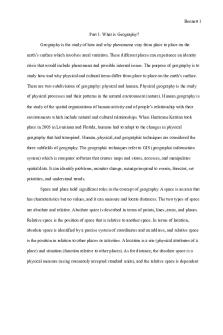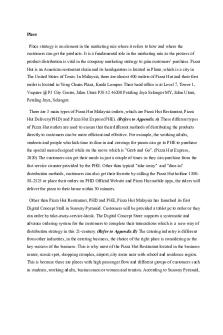Place marketing and place branding: A systematic (and tentatively exhaustive) literature review PDF

| Title | Place marketing and place branding: A systematic (and tentatively exhaustive) literature review |
|---|---|
| Pages | 97 |
| File Size | 2.2 MB |
| File Type | |
| Total Downloads | 351 |
| Total Views | 508 |
Summary
Renaud Vuignier Place marketing and place branding: A systematic (and tentatively exhaustive) literature review Working paper de l’IDHEAP 5/2016 Unité Management public et marketing Place marketing and place branding: A systematic (and tentatively ...
Description
Renaud Vuignier Vuignier Renaud
Place marketing marketing and and place place branding: branding: Place A systematic systematic (and (and tentatively tentatively exhaustive) exhaustive) A literature review review literature
Working paper paper de de l’IDHEAP l’IDHEAP 5/2016 5/2016 Working Unité Management public et marketing
Unité Management public et marketing
Place marketing and place branding: A systematic (and tentatively exhaustive) literature review Renaud Vuignier
May 2016
Working Paper de l’IDHEAP 5/2016 Public Management and Marketing Unit Swiss Graduate School of Public Administration (IDHEAP) University of Lausanne, Switzerland
To contact the author: Renaud.Vuignier at unil.ch or via ch.linkedin.com/in/renaudvuignier
To cite this article: Vuignier, Renaud (2016). Place marketing and place branding: A systematic (and tentatively exhaustive) literature review. Working Paper de l’IDHEAP, 5/2016. Le texte intégral est disponible en ligne sur le dépôt institutionnel de l’UNIL : https://serval.unil.ch/
Place marketing and place branding: A systematic (and tentatively exhaustive) literature review, Renaud Vuignier, May 2016
Place marketing and place branding: A systematic (and tentatively exhaustive) literature review Renaud Vuignier Abstract This paper presents a systematic and complete overview of the scientific literature in the field of place marketing and place branding research. A total of 1172 articles published between 1976 and 2016 in 98 different journals were analyzed and meticulously classified into categories and subcategories according to disciplinary approach, method used and perspective adopted. This literature review thus provides a detailed overview of the state of the art and reveals various trends and developments in this emerging field of study. Among other things, it demonstrates that the field suffers from a lack of conceptual clarity, diverging definitions and a weak theoretical foundation, which means it addresses a very broad range of research topics. In addition, the field lacks empirical evidence and explanatory articles, meaning that the numerous hypotheses concerning the effects of place marketing activities on attractiveness remain unsubstantiated. The review also underscores the literature’s lack of interest in the political and institutional contexts of places, although this information is crucial in terms of public management. Moreover, this work notes that the rhetoric of consultants is given pride of place, with the publication of numerous prescriptive articles focused on sharing best practices. Finally, this study notes the existence of a significant number of critical articles.
Keywords: place, marketing, branding, literature review, state of the art, public management
2
Place marketing and place branding: A systematic (and tentatively exhaustive) literature review, Renaud Vuignier, May 2016
Contents Abstract ...................................................................................................................................................................... 2 Introduction ............................................................................................................................................................................. 4 Place marketing vs. place branding .............................................................................................................................. 5 Related terms ........................................................................................................................................................... 5 Shift from marketing to branding? .................................................................................................................. 7 Assessment from a practical perspective ..................................................................................................... 8 Definitions ................................................................................................................................................................. 9 Origins .......................................................................................................................................................................................10 Origins of practices .............................................................................................................................................. 11 Origins of research ............................................................................................................................................... 12 Recent developments in the field................................................................................................................... 12 Primary existing literature reviews ............................................................................................................................14 The need for a systematic literature review............................................................................................................16 Methodology...........................................................................................................................................................................17 Systematic phase .................................................................................................................................................. 17 Journals selected ................................................................................................................................................... 17 Keywords selected ............................................................................................................................................... 18 Empirical phase ..................................................................................................................................................... 19 Classification ..........................................................................................................................................................................19 Classification by relevance ............................................................................................................................... 20 Classification by disciplinary approach....................................................................................................... 21 Classification by method ................................................................................................................................... 22 Classification by perspective ........................................................................................................................... 22 Findings ....................................................................................................................................................................................23 Keywords ................................................................................................................................................................. 25 Relevance ................................................................................................................................................................. 25 Journals ..................................................................................................................................................................... 25 Disciplinary approaches .................................................................................................................................... 26 Methods .................................................................................................................................................................... 28 Perspectives ............................................................................................................................................................ 29 Recurring themes ................................................................................................................................................. 32 The diversity of place branding research ................................................................................................... 35 Conclusion ...............................................................................................................................................................................38 Future research ..................................................................................................................................................... 40 Bibliography...........................................................................................................................................................................41 3
Place marketing and place branding: A systematic (and tentatively exhaustive) literature review, Renaud Vuignier, May 2016
Introduction “The practice of ‘branding’ has invaded all aspects of public and private life” (van Ham, 2002, p. 249). In fact, in the case of geographic locations (i.e., places), significant effort and resources are being devoted to the development of place marketing and place branding strategies: Switzerland spends millions of francs in public funds each year on such activities1 (Jacobsen, 2009). Numerous public and para-public organizations at every level—local, regional, national, international and cross-border—sometimes even consider these strategies to be crucial to regional management and development. As a result, there is an emerging field of research devoted to the scientific analysis of these practices. The literature on place marketing and place branding is full of idiosyncrasies. As a relatively new multidisciplinary field that is “largely based on anecdotic evidence from single case studies” (Lucarelli & Berg, 2011)2 and influenced by the prescriptive approach of consultants (Aronczyk, 2008; Boland, 2013) and other practitioners (Niedomysl & Jonasson, 2012),3 it is fragmented, lacks empirical data, and requires more academic rigor. Some very recent appraisals (Acharya & Rahman, 2016; Oguztimur & Akturan, 2015) have, in fact, said as much, as have various previous literature reviews (Andersson, 2014; Berglund & Olsson, 2010; Chan & Marafa, 2013; Gertner, 2011a, 2011b; Lucarelli, 2012; Lucarelli & Berg, 2011). However, to date, no systematic and exhaustive overview of this emerging field of study has corroborated these shortcomings. Only a comprehensive literature review can provide a solid foundation for the scientific development of the field and put an end to the observed tendency to systematically reinvent the wheel. While we do note that a variety of articles using different perspectives are being written to address this very theme, these papers are sometimes complementary, sometimes contradictory, and frequently fail
It is difficult to estimate the amount of money spent on place marketing, given the variety of sources (public, para-public and private) and time frames (project-based funding and regular funding). By way of illustration, here are some figures quoted in the literature: US$6 million in Portugal, US$15 million in Italy’s Lombardy region, and US$33 million in Singapore (Jacobsen, 2009). Berlin apparently spends €5 million per year on place marketing (Jacobsen, 2009, 2012), while the German state of Baden-Württemberg spends 7 million (Zenker, 2014, p. 158), the city of Stuttgart, 2.5 million (Jacobsen, 2009), and Hamburg, 4 million (Jacobsen, 2009). In the United Kingdom between 1995 and 1996, 93% of local authorities engaged in place marketing activities, spending an average of £279,600 each (Young & Lever, 1997). Kotler, Haider, & Rein (1993) estimate that 10% of all major newspaper advertising in the United States is used for place marketing. Communities and regions in the United States apparently spend US$538 million annually on place marketing (Jacobsen (2009) citing (Morgan, Pritchard, & Pride, 2002)). Lucarelli & Berg (2011), discussing the Eurocities Questionnaire and the work of Seisdedos (2006), underscore that European cities spend an average of €400,000 on marketing activities, with the actual number varying from £130,000 to £10 million. Brittany’s brand strategy initiative, which seeks to create a more unified image for the area, cost €400,000 (Lupieri, 2013). France is also home to a campaign that will be discussed later called “Je veux Metz!” Costing €800,000, this was funded 80% by the French government and the European Regional Development Fund (ERDF) and 20% by the Metz metropolitan region (CapCom, 2011). 2 “Thus, depending on the scientific and ontological perspectives chosen, it could either be argued that the empirical foundation of the domain is largely based on anecdotic evidence with few comparative studies and even fewer studies attempting to measure the impact of city branding efforts, or that the research domain is founded on rich auto-ethnographic data, often collected in a close collaborative relationship with the city.” (Lucarelli & Berg, 2011, p. 14) “The empirical foundation of the domain is largely based on anecdotic evidence from single case studies, and there are few comparative studies on the impact of different types of branding elements on output or performance data” (Lucarelli & Berg, 2011, p. 22) 3 The authors describe the field as having a very “practitioner-led” approach. 1
4
Place marketing and place branding: A systematic (and tentatively exhaustive) literature review, Renaud Vuignier, May 2016
to reference each other. For these reasons, we decided to conduct a broad (almost exhaustive) and systematic literature review. A total of 1172 articles published between 1976 and 2016 in 98 different journals were identified, using specific criteria to select the journals examined (systematic phase) and a pragmatic approach to find additional items (empirical phase). The articles were then examined closely and classified into categories and subcategories according to disciplinary approach, method used and perspective adopted. Before discussing our methodological choices in detail and presenting the findings of our literature review, we would like to begin by clarifying our position with regard to the terms “place marketing” and “place branding,” briefly explain the origins of and recent developments in this field, and then look at existing literature reviews.
Place marketing vs. place branding To help expose the lack of conceptual clarity in the literature, it is important to begin with a discussion of the very name of the field. Therefore, we decided to review what has been written about these two terms. In the next section, we will discuss the terms “marketing” and “branding,” explain the shift from place marketing to place branding, commenting on the way in which these terms are understood from both an academic and a practical perspective, and present the definitions we ultimately used. Related terms Branding is not synonymous with marketing. According to a classic definition of the term “marketing,”4 branding5 is part of marketing. It is a marketing tool associated with perception, image, mental associations in the minds of target groups, awareness and reputation. Branding refers to the process of managing a brand. It is an endeavor that highlights the brand through activities designed “to establish a significant and differentiated presence in the market.”6 Therefore, for branding to occur, a brand must either exist already or be in the process of being created. In the case of a place, branding creates an identity to encompass all of its commercial activities, in other words, it identifies them with the brand. From a managerial perspective, there
“Marketing is the activity, set of institutions, and processes for creating, communicating, delivering, and exchanging offerings that have value for customers, clients, partners, and society at large” (American Marketing Association, 2015). The basic elements of marketing are an exchange (participants in this exchange and the content of what is being exchanged), the exchange process (how the exchange is conducted) and the relationship between the participants in the exchange, for more on this see Kotler & Dubois (2004). “We define place marketing as the ‘coordinated use of marketing tools supported by a shared customer-oriented philosophy, for creating, communicating, delivering and exchanging urban offerings that have value for the city’s customers and the city’s community at large’” (Eshuis, Klijn, & Braun, 2014, pp. 153-154). 5 “Place branding refers to the development of brands for geographical locations, such as regions, cities or communities, usually with the aim of triggering positive associations and distinguishing the place from others” (Eshuis & Klijn, 2012). “Place brands are symbolic constructs meant to add meaning or value to places. Brands are signs that identify places and evoke associations that imbue places with cultural meaning.” (Braun, 2008, p. 43). 6 The Business Dictionary, http://www.businessdictionary.com/definition/branding.html, consulted May 6, 2016. 4
5
Place marketing and place branding: A systematic (and tentatively exhaustive) literature review, Renaud Vuignier, May 2016
is a difference between branding activities at the operational level and the brand strategy itself.7 The latter defines the brand identity and, in principle, includes a component dedicated to the brand policy, which sets the rules for using the brand. However, despite these differences, the term “place branding” is now commonly used to designate the entire field of place marketing, place branding and brand strategy (Skinner, 2008). Usage can differ, depending on context: American authors, as (Gertner, 2011a, 2011b) points out, seem to systematically favor the appellation “place marketing.” It can also depend on the individual author: more meticulous researchers clearly define and differentiate between the two terms. Nonetheless, recent papers tend to systematically refer to place branding, even in articles that do not focus on the dynamics associated with the brand itself. The literature on place marketing and place branding thus no longer tends to clearly distinguish between marketing and branding, at least when it comes to designating the field of study. The idea of place branding is now defined in such broad, all-encompassing terms that the two terms are confused and used as synonyms (interchangeably) by numerous authors. The phenomenon is evident in this literature review: authors have a tendency to refer to both terms and there is no significant difference in content between articles that appear in the search results for the keyword “place marketing” and those for “place branding,” while recent documents simply appear in both. Conducting the same exercise with Google Scholar corroborates this finding (see Chart 1): the use of the words “place branding” is replacing that of the words “place marketing” (assuming of course that, like our literature review, there is no significant difference in content between the two search results). Chart 1: Number of article titles that include “place branding” or “place marketing,” according to Google Scholar search results (updated February 2, 2016)
“Long-term marketing support for a brand, based on the definition of the characteristics of the target consumers. It includes understanding of their preferences, and expectations from the brand.” (BusinessDictionary, 2016; Sugumaran, 2014, p. 227).
7
6
Place marketing and place branding: A systematic (and tentatively exhaustive) literature review, Renaud Vuignier, May 2016
From a practical standpoint, it is understandable that these two concepts would be considered equivalent. After all, when the ultimate goal is to develop a brand, the action of branding does involve marketing activities. At the implementation...
Similar Free PDFs

Marketing Mix Place
- 1 Pages

Systematic Literature Review
- 9 Pages

Babcock Place - Grade: A
- 1 Pages

A Small Place
- 10 Pages

Time and place of contract
- 16 Pages

Tuan Space and Place and Time
- 7 Pages

Depresion - PLACE
- 3 Pages

Asma - PLACE
- 2 Pages

Alzheimer - PLACE
- 4 Pages

Geography/Place
- 3 Pages

A Small Place - Kincaid summary
- 5 Pages
Popular Institutions
- Tinajero National High School - Annex
- Politeknik Caltex Riau
- Yokohama City University
- SGT University
- University of Al-Qadisiyah
- Divine Word College of Vigan
- Techniek College Rotterdam
- Universidade de Santiago
- Universiti Teknologi MARA Cawangan Johor Kampus Pasir Gudang
- Poltekkes Kemenkes Yogyakarta
- Baguio City National High School
- Colegio san marcos
- preparatoria uno
- Centro de Bachillerato Tecnológico Industrial y de Servicios No. 107
- Dalian Maritime University
- Quang Trung Secondary School
- Colegio Tecnológico en Informática
- Corporación Regional de Educación Superior
- Grupo CEDVA
- Dar Al Uloom University
- Centro de Estudios Preuniversitarios de la Universidad Nacional de Ingeniería
- 上智大学
- Aakash International School, Nuna Majara
- San Felipe Neri Catholic School
- Kang Chiao International School - New Taipei City
- Misamis Occidental National High School
- Institución Educativa Escuela Normal Juan Ladrilleros
- Kolehiyo ng Pantukan
- Batanes State College
- Instituto Continental
- Sekolah Menengah Kejuruan Kesehatan Kaltara (Tarakan)
- Colegio de La Inmaculada Concepcion - Cebu




